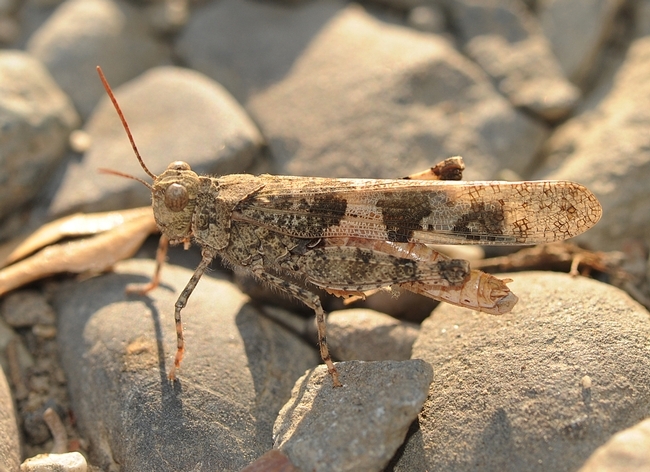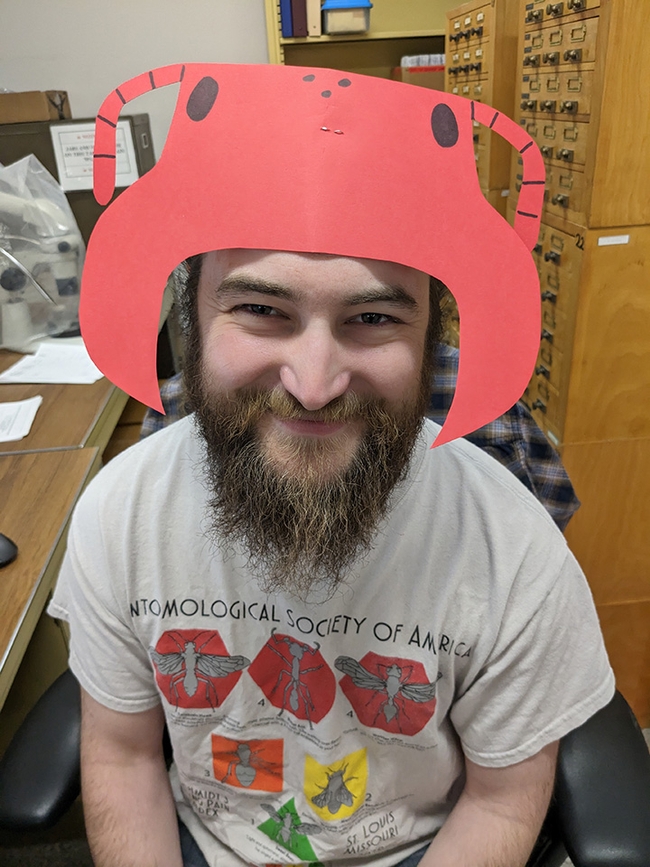- Author: Kathy Keatley Garvey
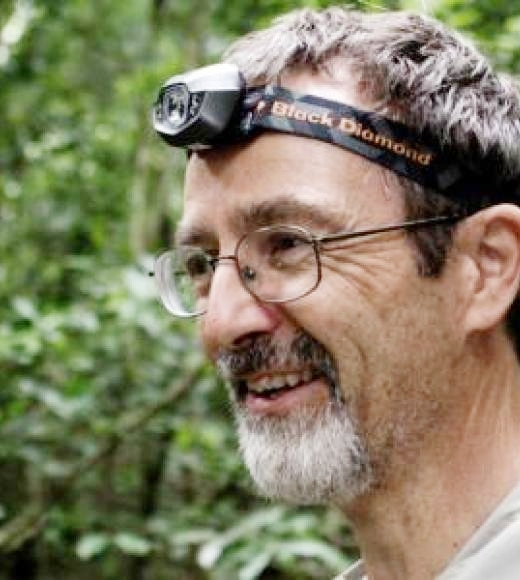
Right.
They belong to the same order, Hymenoptera, but some folks insist that ants don't belong in your life.
Oh, but they do!
Find out why at the Bohart Museum of Entomology open house from 1 to 4 p.m., Sunday, May 21. The event, spotlighting ants, is free and family friendly. It will take place in Room 1124 of the Academic Surge Building, 455 Crocker Lane.
Members of the Phil Ward lab, UC Davis Department of Entomology and Nematology, will answer your questions, show live ants and specimens, and engage in one-on-one discussions.
In a video released by the Bohart Museum of Entomology during a campuswide Biodiversity Museum Day, Professor Ward related: "Ants have occupied almost all of the world's land surfaces, from deserts to rain forests. There's a few places they're absent. They're not in Antarctica, no surprise! They haven't colonized the Arctic and a few very high elevation tropical mountains, but apart from that, almost any place you go on land you'll see our friends, the ants. And they have assumed a quite a diverse array of ecological roles. Some of them are predators, others are scavengers, and some are seed collectors, and these habits vary tremendously among different species in different parts of the world."
Among the Ward lab personnel scheduled to participate are doctoral candidates Jill Oberski and Zach Griebenow (both are expected to receive their PhDs this year), and third-year doctoral student Ziv Lieberman. Griebenow and Oberski are veterans of UC Davis teams that won national championships in the Entomological Society of America's Entomology Games or "Bug Bowls." (See news story) UC Davis teams won national championships in 2022, 2018, 2016 and 2015.
Meanwhile, be sure to watch what Professor Ward says in the video posted on YouTube at https://youtu.be/d8eRNsD8dxo. He illustrated his talk with ant images taken by his former doctoral student Alex Wild (PhD from UC Davis in 2005), curator of entomology at the University of Texas, Austin, and a noted macro photographer, (http://www.alexanderwild.com).
How ancient are ants? Ants originated about 120 million years ago (early Cretaceous), evolving from "wasp-like creatures," Ward said. They are members of the order Hymenoptera, and their closest relatives include honey bees, cockroach wasp and the mud daubers.
How many species in California? California is home to some 300 species of ants, but thousands more live in the tropics. Globally, there may be as many as 40,000 to 50,000 species of ants, the professor estimated, but only about 14,000 are described.
How do they communicate? Ants communicate largely by chemical (pheromones) and tactile means, Ward said. Their vision is "not particularly acute." He pointed out that that they lay a trail pheromones from the source of food back to the nest. They have alarm pheromones, causing other workers to act defensively. Chemicals also help ants distinguish their nest mates.
What about those Argentine ants? Some ants, like the Argentine ants, are pests. These invaders from South America "form super colonies, which means different colonies don't fight each other; they're all cooperating. And the other downside of Argentine ants is that they tend to eliminate native ants. So over the years I've lived in Davis, I have certainly noticed that native ants have declined as the Argentine ants have expanded. And they expand not just in, say, urban areas, but along certain natural habitats and one that they really like is the riparian habitat. So if you look along rivers and streams that are near urban areas, they're getting invaded by Argentine ants. And when they do, most native ants just disappear. This is a very tough aggressive ant and the mellow California ants can't handle an aggressive invader from South America. So they just disappear."
Ward related that ants live in long-lived colonies with (1) cooperative brood care (2) overlapping generations and (3) reproductive division of labor, the hallmarks of eusocial behavior. He also pointed out:
- A typical ant colony contains a reproductive queen, numerous non-reproductive workers and brood (eggs, larvae, pupae)
- Colonies of ants can be thought of as superorganisms: tightly integrated and cooperative entities with complex systems of communication and division of labor (castes)
The Bohart Museum's arts-and-crafts activity will be to create paper ant headbands. "The current version has serrated mandibles, but people can go free form, too," said Tabatha Yang, education and outreach coordinator. "We're hoping for a colony of visitors with red headbands."
The Bohart Museum, directed by UC Davis distinguished professor Lynn Kimsey, houses a global collection of eight million insect specimens, plus a petting zoo (including Madagascar hissing cockroaches, stick insects and tarantulas) and a gift shop, stocked with insect-themed t-shirts, hoodies, jewelry, posters, books, and collecting equipment.
Founded in 1946, the Bohart is open to the public Mondays through Thursdays, from 8 a.m. to noon, and 1 to 5 p.m. More information is available on the Bohart website at https://bohart.ucdavis.edu or by emailing bmuseum@ucdavis.edu.
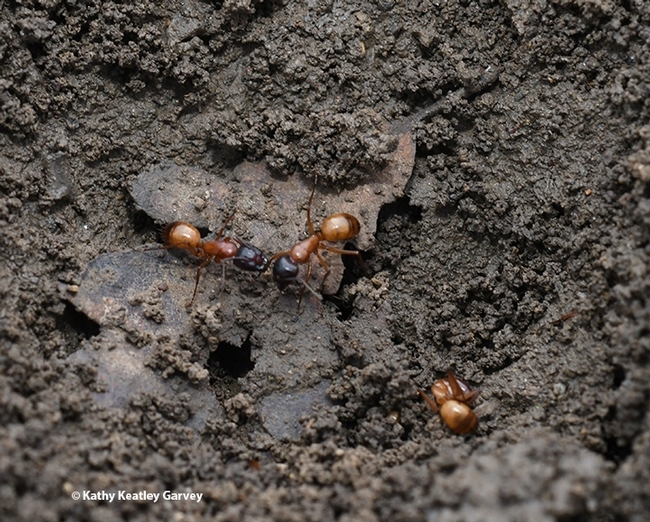
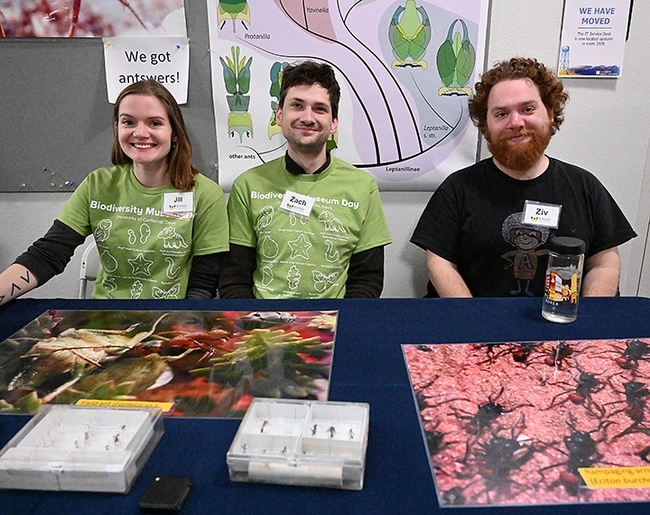
- Author: Kathy Keatley Garvey

Ask it at the "Doctor Is In" bug booth at Briggs Hall from 9 a.m. to 5 p.m., Saturday, April 15 during the 109th annual UC Davis Picnic Day.
The "docs" are two entomologists: doctoral candidate Zachary "Zach" Griebenow and doctoral student Ziv Lieberman. They study ants with major professor Phil Ward, UC Davis Department of Entomology and Nematology.
Want to identify an insect or learn more about it? Bring the insect and/or a photo and they'll answer your questions. Briggs Hall is located off Kleiber Hall Drive.
Griebenow, who joined the Ward lab in 2017, was a member of the UC Davis Linnaean Games team (now renamed the Entomology Games) that won two national championships (2018 and 2022) at the Entomological Society of America (ESA) meetings. He also was a member of Ohio State's Linnaean Games team that won second place in the 2017 national championship.
ESA describes The Games as a "fast-paced, college-bowl style contest in which students from various colleges and universities test their knowledge by answering questions on insect science. Students compete first at the regional branch level, and then the winning teams compete each year at the national level at ESA's Annual Meeting."
By the way, Griebenow will present his exit seminar at 4:10 p.m., Wednesday, April 19 in 122 Briggs Hall on "Systematic Revision of the Ant Subfamily Leptanillinae (Hymenoptera:Formicidae), Reciprocally Illuminated by Phylogenomics and Morphology." (See more on the Department of Entomology and Nematology website.) His presentation also will be virtual.
Lieberman joined the Ward lab in the fall of 2020. Published research includes Revision of the Highly Specialized Ant Genus Discothyrea (Hymenoptera: Formicidae) in the Afrotropics with X-Ray Microtomography and 3D Cybertaxonomy (journal of Insect Systematics and Diversity).
Forensic entomologist Bob Kimsey, and doctoral student Grace Horne of the lab of urban landscape entomologist Emily Meineke are coordinating the department's Picnic Day activities. Briggs Hall activities will take place from 9 a.m. to 5 p.m. The open house at the Bohart Museum of Entomology, located in Room 1124 of the Academic Surge Building, 455 Crocker Lane, is from 10 a.m. to 2 p.m. See schedule of insect activities, including Roach Races and Maggot Art, on Bug Squad blog.
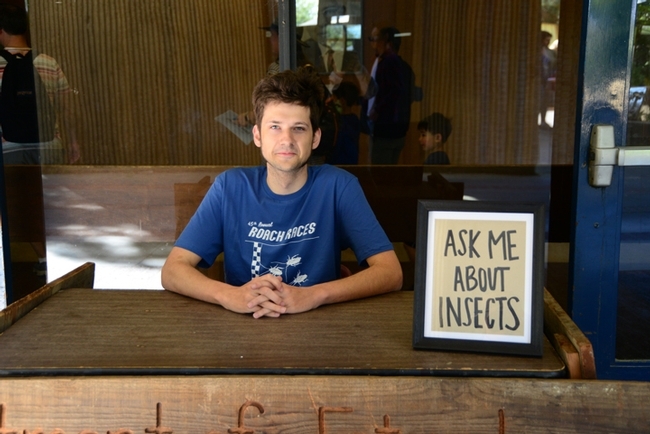
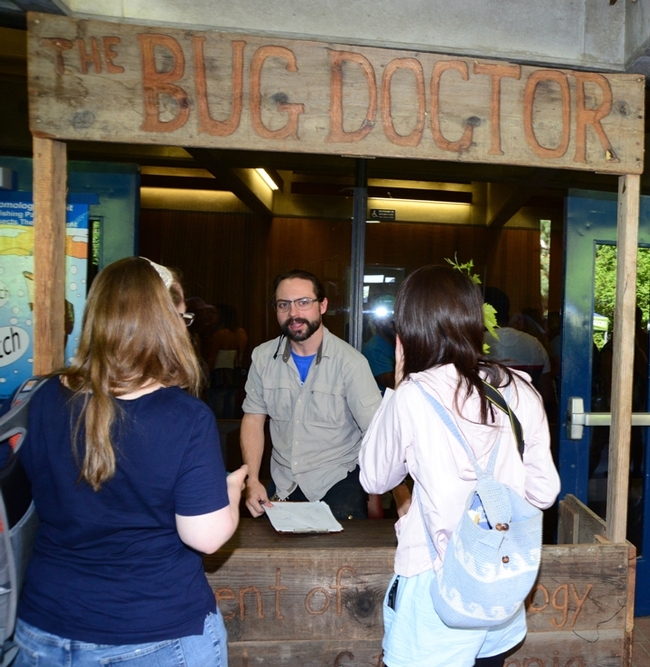
- Author: Kathy Keatley Garvey
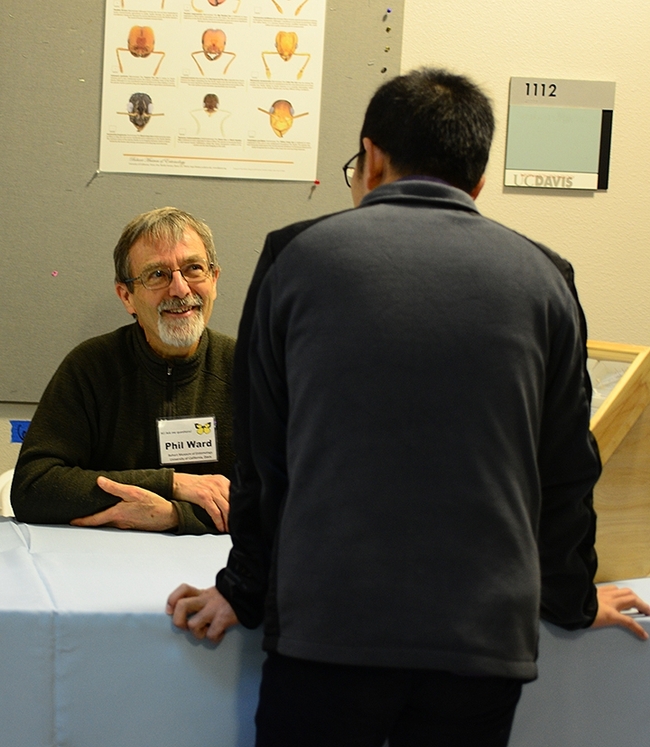
Well, if you were high school student Ziya Akmal, he journeyed--by car--nearly 400 miles from his home in Los Angeles to attend the 12th annual UC Davis Biodiversity Museum Day on Saturday, Feb. 18 on the University of California, Davis, campus.
Biodiversity Museum Day, billed as a Super Science Day, is an annual opportunity to meet the scientists, see their work, and ask questions. It's a great opportunity for students to gain career ideas, said Biodiversity Museum Day chair and co-founder Tabatha Yang, education and outreach coordinator for the Bohart Museum of Entomology.
Akmal said he hopes to enroll in UC Davis, major in entomology, and study ants with Professor Phil Ward, an international authority on ant systematics. Akmal met with the professor in his Briggs Hall office, and talked to three Ward lab members--and one alumnus--at their table in the Academic Surge Building on Crocker Lane.
The Biodiversity Museum Day showcased 11 museums and collections, drawing almost 2000 visitors alone to the Academic Surge Building, where the Bohart Museum of Entomology and the Museum of Wildlife and Fish Biology provided displays. More displays lined the Academic Surge hallway: the Phil Ward lab (ants), the Jason Bond lab (spiders), and the Bohart Museum's separate petting zoos (Madagascar hissing cockroaches and stick insects). Martin Hauser, senior insect biosystematist at the California Department of Food and Agriculture and a regular volunteer at the Biodiversity Museum Day, delighted visitors with a scorpion that he fluoresced.
But across the hall from Hauser were "The Ant People" or "The Myrmecologists" from the Ward lab, who staffed a table and answered questions about not only ants, but a wide variety of arthropods. Doctoral candidates Jill Oberski and Zachary Griebenow and third-year doctoral student Ziv Lieberman were there, as was 2020 alumnus and ant researcher Brendon Boudinot, an Alexander von Humboldt Research Fellow at the Institute of Zoology and Evolutionary Research at Friedrich Schiller University Jena.
Those who listened to Professor Ward deliver a webinar on ants at the 10th annual Biodiversity Museum Day (during COVID-19 pandemic), remembered his presentation (see https://youtu.be/d8eRNsD8dxo.) Ants originated about 120 million years ago (early Cretaceous period), evolving from "wasp-like creatures," Ward said in his webinar. California has some 300 species of ants, but thousands more are in the tropics. Globally, "there may be as many as 40,000 to 50,000 species of ants," but only about 14,000 are described.
Boudinot, Griebenow and Oberski are veterans of UC Davis teams that won national championships in the Entomological Society of America's Entomology Games or "Bug Bowls." The Games, played between university-sponsored student teams, are lively question-and-answer, college bowl-style competitions on entomological facts. To date, UC Davis teams have won four national championships: 2022, 2018, 2016 and 2015.
The UC Davis Biodiversity Museum Day is traditionally held on Presidents' Day weekend. It's free and family friendly.
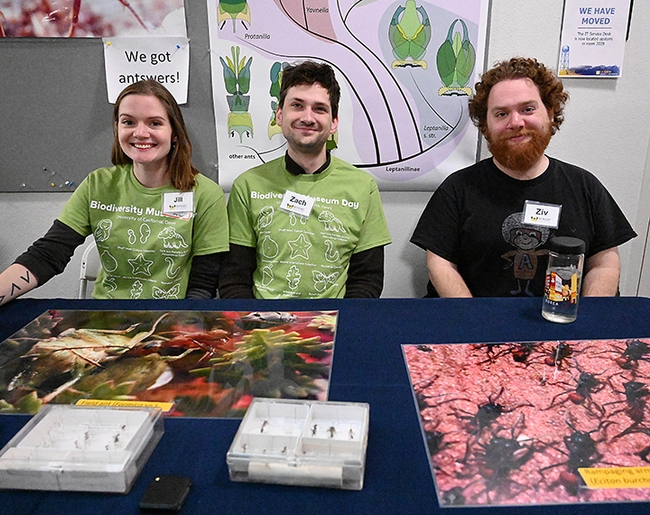
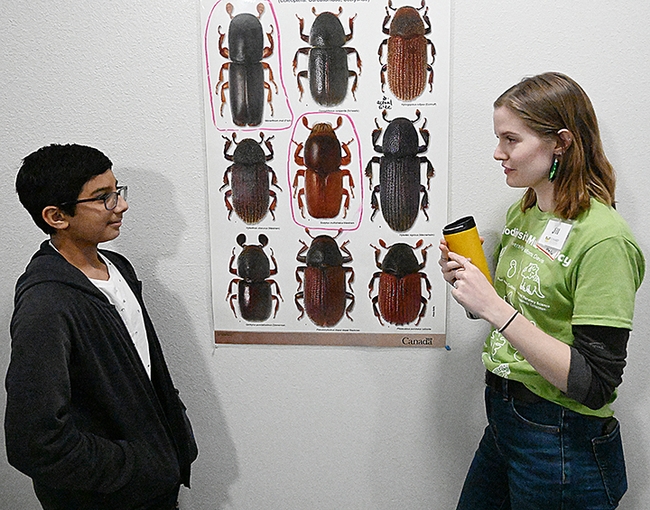
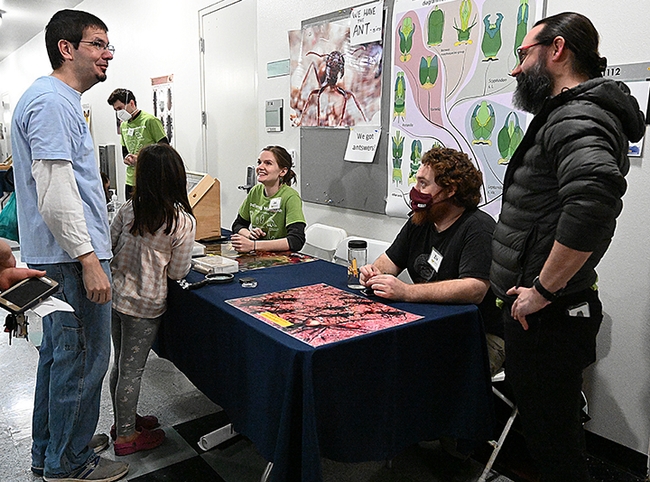
- Author: Kathy Keatley Garvey
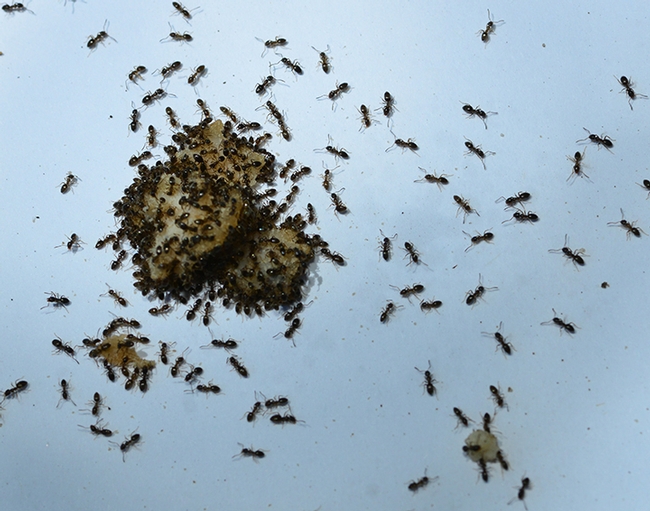
You know you want to!
Did you own--and treasure--an ant farm kit as a kid? Did you ever follow them as they hauled off crumbs from your picnic? Did you marvel at the load they could carry?
“Ants are amazing because they're way more diverse than most people realize,” says UC Davis entomology doctoral candidate Jill Oberski. “Some are huge, some are tiny, some are blue or green, and a lot of them have crazy spines. There are ants that run farms with crops and livestock, and ants that can build bridges and survive floods, and ants that live in the highest treetops and never touch the ground.”
That's just some of the information to be showcased at the UC Davis Biodiversity Museum Month program on Saturday, Feb. 13 from 11 a.m. to noon when three doctoral students in the Phil Ward lab, UC Davis Department of Entomology and Nematology, take the helm. Oberski, a fourth-year doctoral student, and Ziv Lieberman, a first-year doctoral student, will talk about the diversity of ants and field questions, followed by doctoral candidate Zach Griebenow's presentation on his research.
Then on Saturday, Feb. 20, from 11 a.m. to noon, Professor Phil Ward will host "All About Ants," billed as a "fun and lively question and answer session." The programs are free and family friendly. See http://biodiversitymuseumday.ucdavis.edu/live-programs.html for the Zoom links.

Griebenow grew up in rural Kentucky and received his bachelor's degree in entomology in 2017 from The Ohio State University, undertaking undergraduate research with distinction on species boundaries in the Puerto Rican fauna of the subterranean termite Heterotermes (Griebenow et al. 2017).
"As so everyone in the Ward lab, I study how different groups of ants are related to one another, and why they look and behave the way that they do," he said. "Specifically I study an obscure group called the Leptanillinae, which have no common name. As ants go, they are strange, and we know very little about them. So far, I have confidently teased out the major evolutionary relationships among leptanilline ants (Griebenow 2020; Griebenow, in press), but there is a lot more work to be done, particularly in comprehending the often bizarre structural modifications seen in the male Leptanillinae (legs that look like toothbrushes, etc.)."
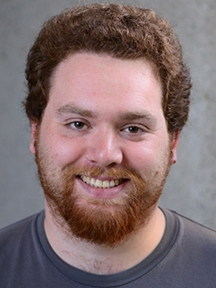
Lieberman, born and raised in California, studied at the College of Marin before transferring to UC Davis to major in evolution, ecology and biodiversity, with a minor in insect evolution and ecology. "Prior to UC Davis, I spent several years working abroad for the California Academy of Science documenting historical ant specimens," Lieberman said. "At the end of my undergrad, I published my first paper, a revision of the poorly-understood (and very cute) African species of the ant genus Discothyrea."
In the Ward lab, Lieberman studies "ant evolution, specifically focusing on connecting evolutionary relationships (the ant 'family tree') with anatomy, using a combination of next-generation imaging techniques and large-scale genetic analyses. In particular, I am interested in describing and comparing internal anatomical features which are usually ignored, and understanding how these traits contribute to biodiversity."
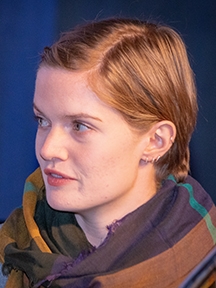
Oberski grew up in Minnesota. "I was fascinated by insects from a very young age," she said. "I attended Macalester College, spent a few confused years on a pre-med track, and ultimately discovered a career in entomology was feasible and worth pursuing. This has led me to Phil Ward's ant systematics lab at UC Davis, where I'm now a PhD candidate."
"My research centers on the ant genus Dorymyrmex, which is commonly found all over the Americas," she said. "Even though they're extremely common (Davis itself is home to two species!), we have no idea how many species there really are. In addition to discovering and naming these species, I'm really interested in biogeography and ancient history: Where did Dorymyrmex originate? How are the North American species related to the South American species? And how did they disperse before the isthmus of Panama was connected?"
Professor Phil Ward
Professor Ward teaches California insect diversity, insect taxonomy and field ecology, and introductory biology (the tree of life). His research interests include systematics, biogeography and evolution of ants; ant-plant mutualisms; phylogeny and speciation. He holds a bachelor of science degree in biology from Queens University, Canada (1973) and a doctorate in zoology from the University of Sydney, Australia (1979).
Due to the COVID-19 pandemic, the 10th annual UC Davis Biodiversity Museum program is all virtual this year via webinars and pre-recorded presentations, and takes place throughout the month of February. The science-based event traditionally occurs on only one day--the Saturday of Presidents' Weekend, when families and friends gather on campus to learn first-hand about the UC Davis museums and collections.
This year's biodiversity event is showcasing 12 museums or collections:
- Anthropology Museum
- Arboretum and Public Garden
- Bohart Museum of Entomology
- Botanical Conservatory
- California Raptor Center
- Center for Plant Diversity
- Häagen-Dazs Honey Bee Haven
- Nematode Collection
- Marine Invertebrate Collection
- Museum of Wildlife and Fish Biology
- Paleontology Collection
- Phaff Yeast Culture Collection
For more information and the schedule, access these two formats on the UC Davis Biodiversity program website: (1) live talks and demonstrations and (2) pre-recorded talks and activities. Information on the biodiversity museum events also appear on social media, including Facebook, Instagram, and Twitter, @BioDivDay.
To help support the Biodiversity Museum event, contributions are being accepted through a month-long crowdfunding campaign program at https://crowdfund.ucdavis.edu/project/24310.
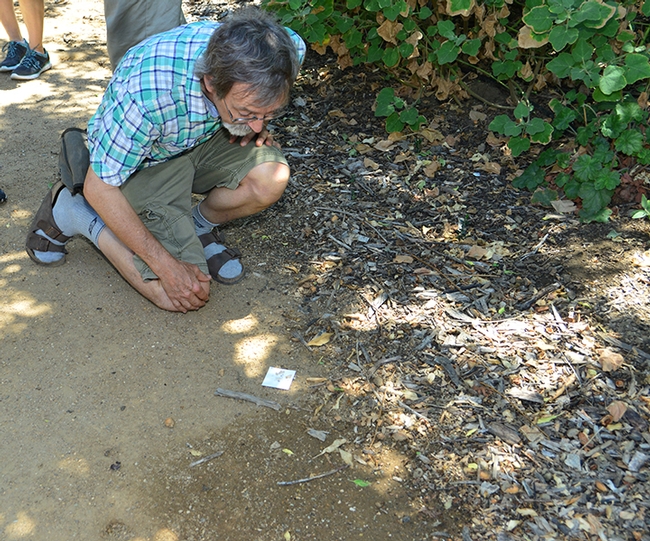
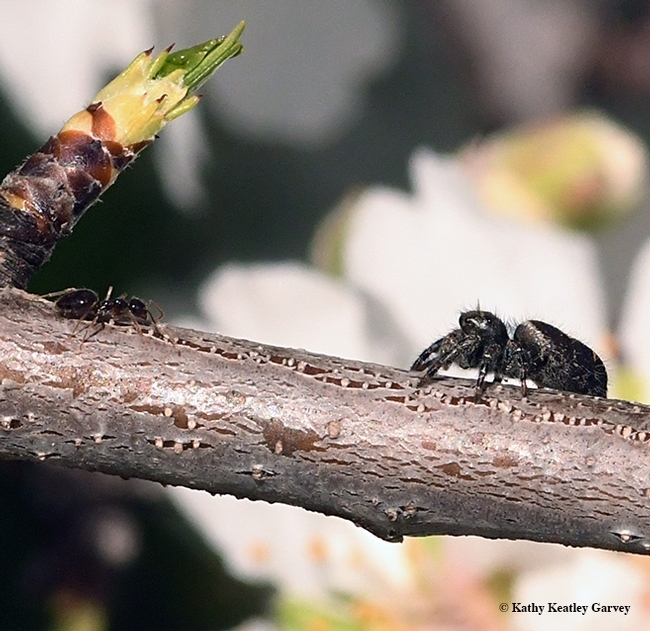
- Author: Kathy Keatley Garvey
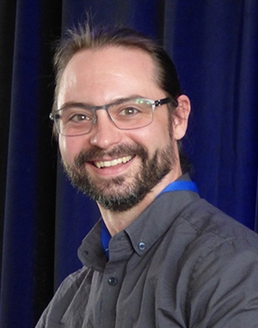
A year-long project on "Current Techniques in Morphology" was posted online today (Nov. 12).
Doctoral candidate Brendon Boudinot of the Phil Ward lab, UC Davis Department of Entomology and Nematology, edited the special collection of articles for the Entomological Society of America journal, Insect Systematics and Diversity (ISD). The work is publicized on EurekAlert! and the entire project can be accessed free online.
Boudinot co-led the development of the collection with István Mikó, collections manager at the University of New Hampshire Department of Biological Sciences.
For the year-long project. Boudinot and Mikó gathered articles illustrating cutting-edge research techniques in insect morphology and phylogenetics, including videos, interactive 3D images, and augmented reality.
"The increasing availability of advanced technologies, such as micro-computed tomography and confocal laser scanning microscopy, are allowing researchers to generate models of morphology in three and four dimensions based on physical data,” Boudinot wrote in the foreword. “These models not only allow for detailed and quantitative study of anatomical systems and their biomechanical properties, but they also allow end-users to experience the richness of morphology in virtual reality, which is incredible."
Boudinot marvels at the 3D models “which open new pathways of research and which you can manipulate on your computer, and another which can project your model in virtual reality on your phone or tablet.”
Boudinot also wrote an editorial on the future of morphology titled Toward Phylomics in Entomology: Current Systematic and Evolutionary Morphology.
Articles in the collection include:
- A Systematist's Guide to Estimating Bayesian Phylogenies From Morphological Data
- PARAMO: A Pipeline for Reconstructing Ancestral Anatomies Using Ontologies and Stochastic Mapping
- From Spinning Silk to Spreading Saliva: Mouthpart Remodeling in Manduca sexta (Lepidoptera: Sphingidae)
- Jumping and Grasping: Universal Locking Mechanisms in Insect Legs
- Revision of the Highly Specialized Ant Genus Discothyrea (Hymenoptera: Formicidae) in the Afrotropics with X-Ray Microtomography and 3D Cybertaxonomy
- Ready Species One: Exploring the Use of Augmented Reality to Enhance Systematic Biology with a Revision of Fijian Strumigenys (Hymenoptera: Formicidae)
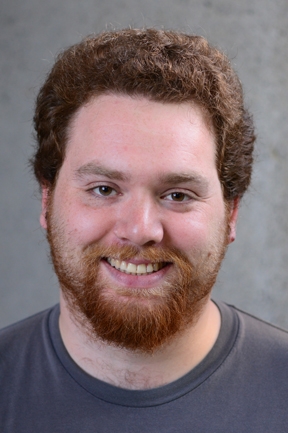
“Morphology, encompassing the study of phenotypic form and function, is one of the ancient branches of human knowledge and is foundational for organismal classification,” Boudinot wrote in his editorial. “Two decades into the current century, the specialized biological knowledge of the history and pattern of evolution has been revolutionized by genome-scale sequencing technologies, and cryptic variation within and among species is quantifiable even with a few genetic markers. The application of statistical phylogenetic models of nucleotide and amino acid substitution to sequence data has enabled revised interpretations of morphological identities—be they population-level generalizations, such as species diagnoses, or the definition and homology of specific anatomical entities—and evolutionary transformation across the tree of life (e.g., insect genitalia, ancestral morphology of Polyneoptera). These models are also being adapted for phylogenetic analysis of morphological data, allowing explicit incorporation of fossil terminals and their stratigraphic information.”
Boudinot coined the word, “Phylomics,” which he said “can be defined as the inference of organismal evolution at the molecular and morphological scale, through the use of genomic and phenomic data (the ‘phenome' being a physical model of the phenotype of an organism, such as seen in the ISD special collection). The idea ultimately is to model the morphology of organisms across the phylogeny, through time, literally depicting ancestors and seeing the transformation from ancestor to descendant across the tree of life.”
UC Davis undergraduate student Ziv Lieberman of the Phil Ward lab (he's a senior majoring in evolution and ecology), and Francisco Hita-Garcia of Okinawa (of the Biodiversity and Biocomplexity Unit and Institute of Science and Technology Graduate University), served as the lead authors of “Revision of the Highly Specialized Ant Genus Discothyrea (Hymenoptera: Formicidae) in the Afrotropics with X-Ray Microtomography and 3D Cybertaxonomy.”
Lieberman and Hita-Garcia and three other co-authors described 15 new species in the genus, which is poorly represented in museum collections. Due to its “cryptic lifestyle, Discothyrea are poorly represented in museum collections and their taxonomy has been severely neglected,” they wrote. “We perform the first comprehensive revision of Discothyrea in the Afrotropical region through a combination of traditional and three-dimensional (3D) cybertaxonomy based on microtomography (micro-CT). Species diagnostics and morphological character evaluations are based on examinations of all physical specimens and virtual analyses of 3D surface models generated from micro-CT data.” These models can be seen for free in their article and online at https://sketchfab.com/arilab/collections/discothyrea.
Additionally, they applied “virtual dissections for detailed examinations of cephalic structures to establish terminology based on homology for the first time in Discothyrea. The complete datasets comprising micro-CT data, 3D surface models and videos, still images of volume renderings, and colored stacked images are available online as cybertype datasets (Hita Garcia et al. 2019, http://doi.org/10.5061/dryad.3qm4183).”
The journal, Insect Systematics and Diversity, launched by ESA in 2017, publishes research on systematics, evolution, and biodiversity of insects and related arthropods, including comparative and developmental morphology, conservation, behavior, taxonomy, molecular phylogenetics, paleobiology, natural history, and phylogeography.
The journal set out to host articles that utilize novel technologies or data types or describe emerging methods of research, ESA spokesperson Lisa Junker said. The new special collection on current techniques in morphology, she said, highlights how Insect Systematics and Diversity has become a premier outlet for integrative research combining multiple subdisciplines within the field.
